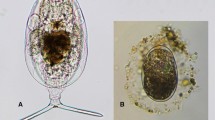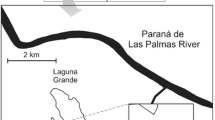Abstract
A detailed analysis of two euplanktonic populations carried out in the same period, 18 May–11 August, 1978, in two neighboring Mazurian lakes revealed different patterns of changes in population densities and significant differences in fecundity, age structure and mean sizes of individuals despite similar epilimnion temperatures in the lakes. Similar densities were maintained in both populations although food limitation was less important and predation more intense in one than in the other of the two lakes. The relative importance of food limitation and predation is discussed in lakes of low and high fertility. It is also suggested that both low food concentration and high selective predation pressure favors small clutch sizes in cladocerans.
Similar content being viewed by others
References
Allan, J. D., 1973. Competition and the relative abundances of two cladocerans. Ecology, 54: 484–498.
Anderson, R. S., 1970. Predatory-prey relationships and predation rates for crustacean zooplankters from some lakes in western Canada. Can. J. Zool. 48: 1229–1240.
Botrell, H. H., A. Duncan, Z. M. Gliwicz, E. Grygierek, A. Hercig, A. Hillbricht-Ilkowska, A. Kurasawa, P. Larsson & T. Wegleńska, 1976. A review of some problems in zooplankton production studies. Norw. J. Zool. 24: 419–456.
Brandl, Z. & C. H. Fernando, 1975. Investigations on the feeding of carnivorous cyclopoids. Verh. int. Verh. Limnol. 19: 2959–2965.
Burns, C. W., 1968. Direct observations of mechanisms regulating feeding behaviour of Daphnia in lakewater. Int. Revue ges. Hydrobiol. 53: 83–100.
Burns, C. W. & F. H. Rigler, 1967. Comparison of filtering rates of Daphnia rosea in lake water and in suspensions of yeast. Limnol. Oceanogr. 12: 492–502.
De Bernardi, R., 1974. The dynamics of a population of Daphnia hyalina Leydig in Lago Maggiore, Northern Italy. Mem. Ist. Ital. Idrobiol. 31: 221–243.
Dodson, S. J., 1974a. Zooplankton competition and predation: An experimental test of size-efficiency hypothesis. Ecology, 55: 605–613.
Dodson, S. J., 1974b. Adaptive significance in plankton morphology in response to size-selective predation: A new hypothesis of cyclomorphosis. Limnol. Oceanogr. 19: 721–729.
Fedorenko, A. Y., 1975. Instar and species-specific diets in two species of Chaoborus. Limnol. Oceanogr. 20: 238–249.
Galbraith, M. G., Jr., 1967. Size-selective predation on Daphnia by rainbow trout and yellow perch. Trans. amer. Fish. Soc. 96: 1–10.
Ghilarov, A. M., 1980. Razmernaja struktura trjoch prirodnych populacij Daphnia cucullata G.O. Sars (Cladocera, Crustacea) i ejo svjaz s dinamikoj cislennosti. Zool. Z. (in press).
Gliwicz, Z. M., 1969. Studies on the feeding of pelagic zooplankton in lakes with varying trophy. Ekol. pol. A. 17: 665–708.
Gliwicz, Z. M., 1974. Trophic status of freshwater zooplankton species. Wiad. ekol. 20: 197–206.
Gliwicz, Z. M., 1975. Effect of zooplankton grazing on photosynthetic activity and composition of phytoplankton. Verh. int. Ver. Limnol. 19: 1490–1497.
Gliwicz, Z. M., 1977. Food size selection and seasonal succession of filter feeding zooplankton in an eutrophic lake. Ekol. pol. 25: 179–225.
Gliwicz, Z. M., 1981. Food and predation in limiting clutch size of cladocerans. Verh. int. Ver. Limnol. 21 (in press).
Gliwicz, Z. M., A. Hillbricht-Ilkowska & t. Wegleńska, 1978. Contribution of fish and invertebrate predation to the elimination of zooplankton biomass in two Polish lakes. Verh. int. Ver. Limnol. 20: 1007–1011.
Gliwicz, Z. M. & E. Siedlar, 1980. Food size limitation and algae interfering with food collection in Daphnia. Arch. Hydrobiol. 88: 155–177.
Golterman, H. L. & R. S. Clymo (eds), 1968. Methods for chemical analysis of fresh waters. IBP Handbook No 8, Blackwell Scientific Publications, Oxford and Edinburgh, 166 pp.
Hall, D. J., 1964. An experimental approach to the dynamics of a natural population of Daphnia galeata mendotae. Ecology, 45: 94–112.
Hall, D. J., S. T. Threlkeld, C. W. Burns & P. H. Crowley, 1976. The size-efficiency hypothesis and the size structure of zooplankton communities. Ann. Rev. Ecol. Syst. 7: 177–208.
Hillbricht-Ilkowska, A., 1977. Trophic relations and energy flow in pelagic plankton. Pol. ecol. Stud. 3: 3–98.
Hrbácek, J., 1977. Competition and predation in relation to species composition of freshwater zooplankton, mainly Cladocera. In: Aquatic Microbial Communities (J. Cairns, Jr. ed.), Garland Publishing, Inc. New York, London. 305–353.
Hrbácek, J. & M. Hrbáckova-Esslová, 1960. Fish stock as a protective agent in the occurrence of slow-developing dwarf species and strains of the genus Daphnia. Int. Revue ges. Hydrobiol. 45: 355–358.
Hrbáckova, M., 1971. The size distribution of neonates and growth of Daphnia hyalina Leydig (Crustacea, Cladocera) from Lago Maggiore under laboratory conditions. Mem. Ist. Ital. Idrobiol. 27: 357–367.
Kajak, Z., 1978. An outline of structure and function of the eutrophic temperate Lake Mikolajskie ecosystem Verh. int. Ver. Limnol. 20: 1005–1006.
Kajak, Z. & J. Rybak, 1979. The feeding of Chaoborus flavicans Meigen (Diptera, Chaoboridae) and its predation on lake zooplankton. Int. Rev. ges. Hydrobiol. 64: 361–378.
Karabin, A., 1974. Studies on the predatory role of the cladoceran Leptodora kindtii (Focke) in secondary production of two lakes with different trophy. Ekol. pol. 22: 295–310.
Kerfoot, W. C., 1974. Egg-size cycle of a cladoceran. Ecology, 55: 1259–1270.
Kerfoot, W. C., 1975. The divergence of adjacent populations. Ecology, 56: 1298–1313.
Kerfoot, W. C., 1977a. Competition in cladoceran communities: the cost of evolving defenses against copepod predation. Ecology, 58: 303–313.
Kerfoot, W. C., 1977b. Implications of copepod predation. Limnol. Oceanogr. 22: 316–326.
Korinek, V., 1980. Slow growth rates of Daphnia populations from oligotrophic lakes. J. Fish. Res. Board Canada, in press.
Lampert, W., 1977. Studies on the carbon balance of Daphnia pulex De Geer as related to environmental conditions. II. The dependence of carbon assimilation on animal size, temperature, food concentration and diet species. Arch. Hydrobiol. Suppl. 48: 310–335.
Lampert, W., 1978. A field study on the dependence of the fecundity of Daphnia spec. onfood concentration. Oecologia 36: 363–369.
Lynch, M., 1978. Complex interactions between natural coexploiters — Daphnia and Ceriodaphnia. Ecology, 59: 552–564.
Neill, W. E., 1975. Experimental studies of microcrustacean competition, community composition and efficiency of resource utilization. Ecology, 56: 809–826.
Paloheimo, J. E., 1974. Calculation of instantaneous birth rate. Limnol. Oceanogr. 19: 692–694.
Patalas, K., 1954. Zespoly skorupiaków pelagicznych 28 jezior pomorskich. Ekol. pol. 2: 61–92.
Patalas, K., 1963. Sezonowe zmiany w pelagicznym planktonie skorupiakowym 6 jezior okolic Wegorzewa. Roczn. Nauk Roln. 82 B, 2: 209–234.
Pijanowska, J., 1980a. Zooplankton communities in nine Masurian lakes. Ekol. pol. 28: 451–465.
Pijanowska, J., 1980b. Podloze, przyczyny i znaczenie zmiennosci morfologicznej organizmów planktonowych. Wiad. ekol. 26: 3–23.
Poliscuk, L. V., 1980. Sravnitelnaja ocenka razlicnych metodov opredelenija rozdaemosti i smertnosti planktonnych zivotnych. Z. Obsc. Biol. 41: 125–137.
Porter, K. G., 1976. Enhancement of algal growth and productivity by grazing zooplankton. Science, 192: 1332–1334.
Porter, K. G., 1977. The plant-animal interface in freshwater ecosystems. Amer. Sci. 65: 159–170.
Prepas, E. & F. H. Rigler, 1978. The enigma of Daphnia death rates. Limnol. Oceanogr. 23: 970–988.
Sterzyńska, M., 1976. Zróznicowanie gatunkowe zooplanktonu w 30 jeziorach pomorskich o róznej trofii. M. SC. Thesis, University of Warsaw, Warsaw, 51 pp.
Sterzyński, W., 1979. Fecundity and body size of planktonic rotifers in 30 Polish lakes of various trophic state. Ekol. pol. 27: 307–321.
Strickland, I. D. H. & T. R. Parsons, 1968. A practical handbook of seawater analysis. Bull. Fish. Res. Bd. Can. 167, 311 pp.
Threlkeld, S. T., 1976. Starvation and the size structure of zooplankton communities Freshwat. Biol. 6: 489–496.
Threlkeld, S. T., 1979. Estimating cladoceran birth rates: The importance of egg mortality and the egg age distribution. Limnol. Oceanogr. 24: 601–612.
Webster, K. E. & R. H. Peters, 1978. Some size-dependent inhibitions of larger cladoceran filterers in filamentous suspensions. Limnol. Oceanogr. 23: 1238–1245.
Wells, L., 1970. Effects of alewife predation on zooplankton populations in Lake Michigan. Limnol. Oceanogr. 15: 556–565.
Wegleńska, T., 1970. Zagadnienie wplywu temperatury i pokarmu na rozwój, wzrost osobniczy i plodność zooplanktonu. Wiad. ekol. 16: 3–21.
Wegleńska, T., 1971. The influence of various concentrations of natural food on the development, fecundity and production of planktonic crustacean filtrators. Ekol. pol. 19: 427–473.
Wright, J. C., 1965. The population dynamics and production of Daphnia in Canyon Ferry Reservoir, Montana. Limnol. Oceanogr. 10: 583–590.
Zaret, T. M., 1972. Predators, invisible prey, and the nature of polymorphism in the Cladocera (class Crustacea). Limnol. Oceanogr. 17: 171–184.
Zaret, T. M., 1975. Strategies for existance of zooplankton prey in homogenous environment. Verh. int. Ver. Limnol. 19: 1484–1489.
Zaret, T. M., 1978. A predation model of zooplankton community structure. Verh. int. Ver. Limnol. 20: 2496–2500.
Author information
Authors and Affiliations
Rights and permissions
About this article
Cite this article
Gliwicz, Z.M., Ghilarov, A. & Pijanowska, J. Food and predation as major factors limiting two natural populations of Daphnia cucullata Sars. Hydrobiologia 80, 205–218 (1981). https://doi.org/10.1007/BF00018359
Received:
Published:
Issue Date:
DOI: https://doi.org/10.1007/BF00018359




